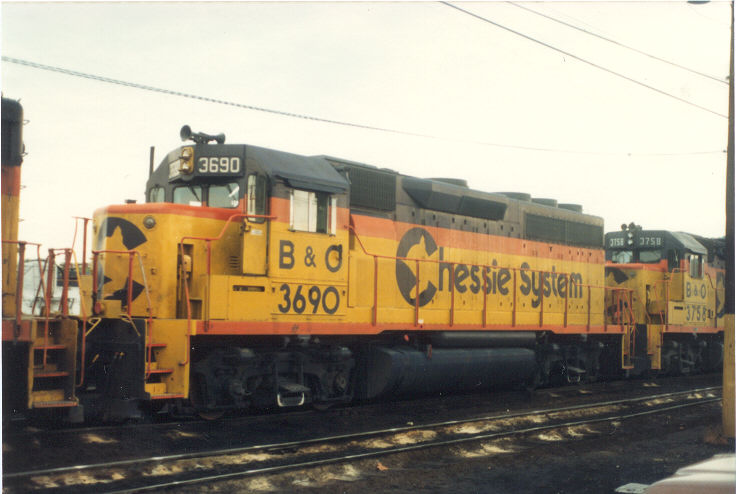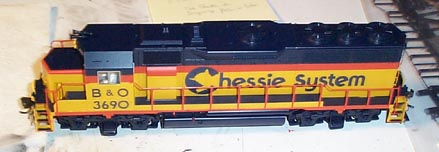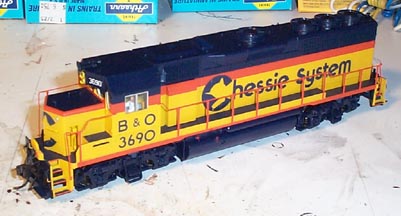Below is a Dean Heacock pic of #3690.

How to make an Atlas GP40 #3690:
1. This is an easy project. Atlas does
most
of the work for you.
2. The biggest problem here is that some of
the
parts are the wrong colors. You will need to paint the
ends of the
uncoupling levers yellow instead of blue, the back sides and
underneath
the steps needs to be blue not yellow (it is basically unpainted
by Atlas,
you can see the area very clearly in the first pic below, just
inside the
back stair case, in the tunnel), the tabs on the bottom of the
orange colored
sill (right below the #3690 and one near the back) need to be
blue not
orange, the class lights (2 on the nose and 2 on the back need
to be silver
(they are unpainted by Atlas), and finally the mu stand.
It is visible
just to the right of the drop step in the first pic. It
should have
a red cap cover and the top should be yellow not blue.
3. The bell is in the wrong position.
It
is mounted low on the left side. It should be side mounted
high on
the left side. You will need a details west side hood
mounted bell
to be accurate.
4. The battery boxcovers should have a slot
in
them. Now you could cut and sand and try to get the Cannon
detailed
Chessie slotted battery box cover in there, but I just added a
strip of
black decal to mine.
5. Weather the locmotive lightly. I
use C&O
enchantment blue straight out of the bottle first. Then,
successively
lighter shades (lightened with white paint). I do very
little weathering
to the orange stripe or yellow body. These tended to hide
the wear
and dirt well. The trucks and fuel tank are always the
first to get
dirty. Concentrate on this part. Compare my pics
below to see
how weathering really changes the appearance. Streak the
bottom of
the battery box with brown and black. This is one of the
few areas
on all Chessie locomotives to be dirty.
6. Tape over the windows and spray the
entire locomotive
with dull coat.
7. Streak oily black (glossy sheen) onto the
fuel
tank to simulate spills.
8. Add the handrails. Weather slightly
the
parts where you would hold climbing the steps.
9. You are done. Enjoy your
locomotive.
Below is a pic of my #3690 as it looked coming
out of
the box.
Below are two pics of 3690 without the nice
layout backdrop.
I am working on this project now, so stay tuned for updates.

Below is an inwork pic of 3690. Steps 1-4
have been
done. Compare with the pics above to see the subtle
changes.
You can just see the bell behind the cab in the blue part.
The tabs
are now blue, there is a "slotted" battery box, etc..

Below are two pics of the finished product.
Notice
that the weathering has been done and the engine looks like it
has seen
some duty. I didn't want this locomotive to look too
grungy.
Some of Chessie's locomotives looked relatively clean.
Below is a close up of the nose of #3690.
You can
really see the yellow top and red cap of the MU stand. The
tops of
the cab and long hood have been drybrushed to bring out the
detail.
Of note too is the way the walk ways have worn in the
middles. This
is normal for a locomotive.